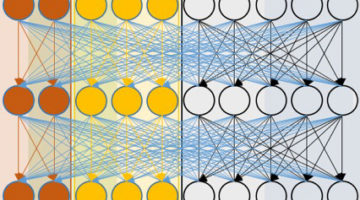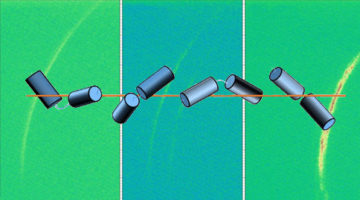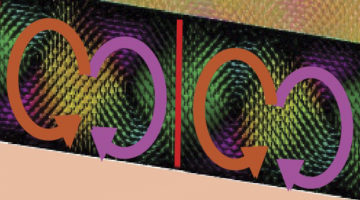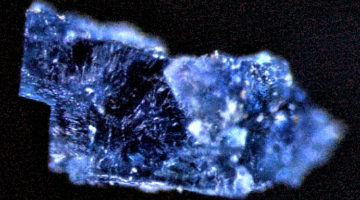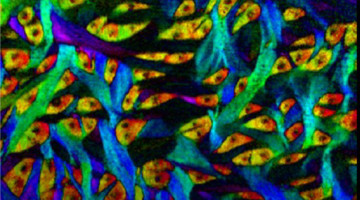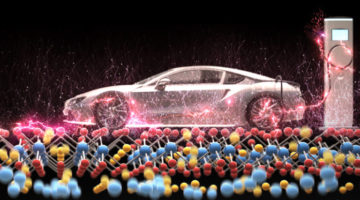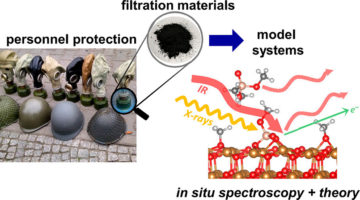Machine-learning techniques have been used to integrate fine- and large-scale infrared characterizations of shale—sedimentary rocks composed of minerals and organic matter. Understanding shale chemistry at both the nano and mesoscale is relevant to energy production, climate-change mitigation, and sustainable water and land use. Read more »
Science Briefs
Clarifying the Working Principle of a High-Capacity Battery Electrode
Operando x-ray absorption spectroscopy experiments revealed the electrochemical reaction mechanism of molybdenum disulfide (MoS2) electrodes in lithium-ion battery cells. The work unambiguously clarifies that the MoS2 conversion reaction is not reversible and that the Li2S formed is converted to sulfur in the first charge process. Read more »
Imaging Magnetic Microstructure Response to Substrate Strain
A ferromagnetic thin film on a piezoelectric substrate offers a way to control magnetization in ultralow-power devices by relying on coupling between the piezoelectric and ferromagnetic components. At the ALS, researchers were able to image the electrically induced magnetic behavior and correlate it with the piezo-strain driving it. Read more »
Twisted Structures Emerge from Achiral Molecules
The spontaneous formation of chiral structures from achiral molecules could shed light on the origin of biological homochirality—how one type of chirality dominated the other in certain biological molecules. Here, resonant soft x-ray scattering (RSoXS) has been used to explore helical phases that emerge from achiral asymmetric dimers. Read more »
X-Ray Handedness Reveals Handedness of Electronic Vortices
Electronic vortex structures have been found to emerge from engineered samples of alternating complex-oxide layers. Resonant soft x-ray diffraction (RSXD) studies using circularly polarized x-rays revealed the vortices’ left- and right-handedness. The intriguing results open the door to electrically controllable chiral devices. Read more »
Ingredients for Life Revealed in Meteorites
X-ray absorption spectroscopy and other techniques were used to measure the organic chemical components in a pair of meteorites that crashed to Earth in 1998. The study treads new ground in solar system history and asteroid geology, surfacing exciting possibilities for the existence of life elsewhere in Earth’s neighborhood. Read more »![]()
The Microstructure of a Parrotfish Tooth Contributes to Its Toughness
Parrotfish chew on coral, producing hundreds of pounds of sand each year. Mapping the microstructure of parrotfish teeth, scientists found bundles of crystals interwoven like chain mail. The results provide a blueprint for creating ultra-durable materials for mechanical components that undergo repetitive contact, movement, and abrasion. Read more »
A Path to a Game-Changing Battery Electrode
If you add more lithium to the positive electrode of a lithium-ion battery, it can store much more charge in the same amount of space, theoretically powering an electric car 30 to 50 percent farther between charges. But these lithium-rich cathodes quickly lose voltage, and years of research have not been able to pin down why—until now. Read more »![]()
Ferromagnetism Emerges to Alleviate Polar Mismatch
A polar mismatch between nonferromagnetic materials drives an electronic reconstruction in which interfacial ferromagnetism is induced. The emergence of such functionality at interfaces could enable new types of electronics for a range of applications, including logic, memory, sensing, and more. Read more »![]()
Studying Gas Mask Filters So People Can Breathe Easier
Scientists have put the x-ray spotlight on composite materials in respirators used by the military, police, and first responders. The results provide reassuring news about the effectiveness of current filters and provide fundamental information that could lead to more advanced gas masks as well as protective gear for civilian applications. Read more »
- « Previous Page
- 1
- …
- 13
- 14
- 15
- 16
- 17
- …
- 22
- Next Page »
